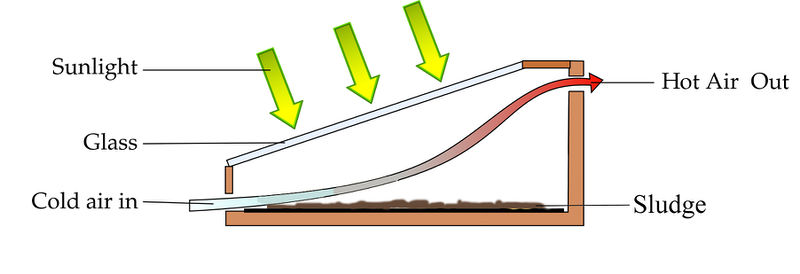Solar Sludge Drying: Difference between revisions
Jump to navigation
Jump to search
(Created page with "Concept that uses solar thermal energy harvested in a greenhouse-type form factor to dry agricultural and other sludges, such as biogas slurry or sewage. Can enable conversion...") |
No edit summary |
||
| (3 intermediate revisions by the same user not shown) | |||
| Line 1: | Line 1: | ||
[[Category: Materials]] | |||
Link: http://www.thermo-system.com/en/home/ | [[File:Solar drying system.jpg|800px|thumb|Solar sludge dryer: dries sludge with solar heat in a well-ventilated greenhouse. ]] | ||
Technology to use solar thermal energy collected in a greenhouse-type facility to dry agricultural and other wet material, such as sludges, biogas slurry or sewage. Can enable conversion of a waste into a feedstock for another process (e.g. biogas slurry into compost). The main goal is volume and weight reduction. It can achieve microbial conversion, e.g. killing of anaerobes. | |||
Variation on the idea: to use some kind of waste energy instead of solar energy (benefit: more independence of weather conditions, more versatile, etc.). These can both be combined. This makes good use of low-level waste heat from other processes. | |||
The technology is patented. | |||
Link: [http://www.thermo-system.com/en/home/ Thermo System] | |||
Latest revision as of 20:43, 12 March 2016
Technology to use solar thermal energy collected in a greenhouse-type facility to dry agricultural and other wet material, such as sludges, biogas slurry or sewage. Can enable conversion of a waste into a feedstock for another process (e.g. biogas slurry into compost). The main goal is volume and weight reduction. It can achieve microbial conversion, e.g. killing of anaerobes.
Variation on the idea: to use some kind of waste energy instead of solar energy (benefit: more independence of weather conditions, more versatile, etc.). These can both be combined. This makes good use of low-level waste heat from other processes.
The technology is patented.
Link: Thermo System
